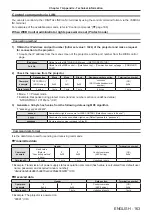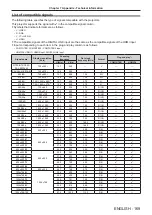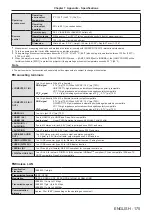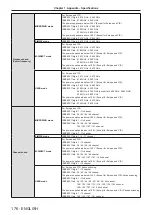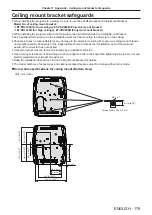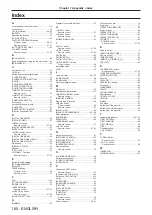
Glossary for network functions
Item
Descriptions
Access point
These are stations for relaying electromagnetic signals between computers in a wireless LAN. When a
computer is connected to an access point, it can communicate through the network connected to the
access point.
AES
Next generation standard cryptography standardized by the National Institute of Standards and Technology
(NIST).
AES: Advanced Encryption Standard
DEFAULT GATEWAY
The devices that are used for different network standards from yours. Default Gateway enables a
connection with other network, by adjusting bilateral differences such as communication protocols. If no
gateway is specified for the IP address of access destination, data will be sent to the host set as the default
gateway.
DHCP
Abbreviation for Dynamic Host Configuration Protocol. This function automatically assigns IP addresses
to the connected equipment. If a device with the DHCP server function is present within a LAN, it
automatically assigns IP addresses to the connected equipment.
EAP
Abbreviation of PPP Extensible Authentication Protocol. An authentication protocol extended from
PPP, which is used for user authentication for remote access. MD5, TLS, S/Key, etc. are supported as
authentication methods. This protocol is adopted by the wireless LAN authentication standard IEEE802.1X,
and available methods include EAP-TLS/EAP-TTLS/EAP-LEAP/EAP-PEAP/EAP-MD5.
EAP-FAST
Abbreviation of EAP-Flexible Authentication via Secure Tunneling. It is one of the wireless authentication
methods compatible with IEEE802.1X. It does not require digital authentication, but establishes a tunnel
for the authentication process using a secret key cryptosystem, and authenticates the tunnel mutually to
improve security. Cisco’s proprietary method.
EAP-TTLS
Abbreviation of EAP-Tunneled Transport Layer Security. It is one of the wireless authentication
methods compatible with IEEE802.1X. It performs mutual authentication with a digital certificate by the
authentication server, and ID/password by the client. A tunnel is established for the authentication process.
Developed by Func Software in the U.S.
GTC
(EAP-GTC)
Abbreviation of EAP-Generic Token Card. It is one of the wireless authentication methods compatible with
IEEE802.1X. Authentication is performed with ID and password. Password is acquired from a security
token.
IP ADDRESS
Internet Protocol (IP) is a protocol for distributing data, and the address corresponding to the data
distribution destination is called the IP address. The same IP address cannot be used within the same LAN.
LAN
Abbreviation for Local Area Network. This is a network with a relatively narrow range such as inside a
company.
MAC Address
Each network adapter has its own ID No.
A discrete ID No. is assigned to each and every network adapter around the world. These IDs are used
to exchange data between adapters. These IDs are a combination of a discrete number managed and
assigned by the IEEE to each individual manufacturer and a unique number assigned to each individual
adapter by the manufacturer.
MD5 (EAP-MD5)
Abbreviation of EAP-Message digest algorithm 5. It is one of the wireless authentication methods
compatible with IEEE802.1X. Authentication is performed with ID and password. Password is sent
encrypted with challenge & response method.
MS-CHAPv2
(EAP-MS-CHAPv2)
Abbreviation of EAP-Microsoft Challenge Handshake Authentication Protocol v2. It is one of the wireless
authentication methods compatible with IEEE802.1X.It performs mutual authentication using a one-way
encrypted password.
Open System / OPEN
This is an authentication of wireless signals employing a public key encryptosystem.
PEAP
Abbreviation for EAP-Protected EAP. It is one of the wireless authentication methods compatible with
IEEE802.1X. It performs mutual authentication with a digital certificate by the authentication server, and ID/
password by the client.
RADIUS server
RADIUS is an abbreviation of Remote Access Dial In User authentication Service, and it is a protocol used
for authentication in various networks such as wireless LAN. An authentication server compatible with the
protocol is called a RADIUS server.
The RADIUS server eliminates the need of registering user information separately in each device even
when there are multiple network devices, and enables integrated management of multiple network devices
and users.
Shared Key / SHARED
This is a secret key encryptosystem for wireless signals in which authentication is performed with a key
pre-set in the WEP.
Other terms for this method, in which the same key is used for both encryption and decryption, are “shared
key encryptosystem” and “common key encryptosystem”.
SSID
Abbreviation for Service Set ID. The SSID identification code must be set to distinguish equipment included
in a wireless LAN that uses access points from equipment not included in that LAN.
This may appear as the “ESSID” or the “network name” for wireless LAN adapters made by some
manufacturers.
172 -
ENGLISH
Chapter 7 Appendix - Glossary for network functions






